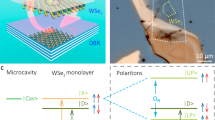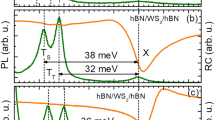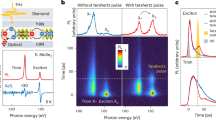Abstract
Photon upconversion is an elementary light–matter interaction process in which an absorbed photon is re-emitted at higher frequency after extracting energy from the medium. This phenomenon lies at the heart of optical refrigeration in solids1, where upconversion relies on anti-Stokes processes enabled either by rare-earth impurities2 or exciton–phonon coupling3. Here, we demonstrate a luminescence upconversion process from a negatively charged exciton to a neutral exciton resonance in monolayer WSe2, producing spontaneous anti-Stokes emission with an energy gain of 30 meV. Polarization-resolved measurements find this process to be valley selective, unique to monolayer semiconductors4. Since the charged exciton binding energy5 closely matches the 31 meV A1′ optical phonon6,7,8,9, we ascribe the spontaneous excitonic anti-Stokes to doubly resonant Raman scattering, where the incident and outgoing photons are in resonance with the charged and neutral excitons, respectively. In addition, we resolve a charged exciton doublet with a 7 meV splitting, probably induced by exchange interactions, and show that anti-Stokes scattering is efficient only when exciting the doublet peak resonant with the phonon, further confirming the excitonic doubly resonant picture.
This is a preview of subscription content, access via your institution
Access options
Subscribe to this journal
Receive 12 print issues and online access
$259.00 per year
only $21.58 per issue
Buy this article
- Purchase on SpringerLink
- Instant access to full article PDF
Prices may be subject to local taxes which are calculated during checkout




Similar content being viewed by others
References
Pringsheim, P. Bemerkungen über den Unterschied von Lumineszenz-und Temperaturstrahlung. Z. Phys. 57, 739–746 (1929).
Epstein, R. I. et al. Observation of laser-induced fluorescent cooling of a solid. Nature 377, 500–503 (1995).
Zhang, J., Li, D., Chen, R. & Xiong, Q. Laser cooling of a semiconductor by 40 kelvin. Nature 493, 504–508 (2013).
Xiao, D., Liu, G.-B., Feng, W., Xu, X. & Yao, W. Coupled spin and valley physics in monolayers of MoS2 and other group-VI dichalcogenides. Phys. Rev. Lett. 108, 196802 (2012).
Jones, A. M. et al. Optical generation of excitonic valley coherence in monolayer WSe2 . Nature Nanotech. 8, 634–638 (2013).
Tonndorf, P. et al. Photoluminescence emission and Raman response of monolayer MoS2, MoSe2, and WSe2 . Opt. Express 21, 4908–4916 (2013).
Sahin, H. et al. Anomalous Raman spectra and thickness-dependent electronic properties of WSe2 . Phys. Rev. B 87, 165409 (2013).
Chen, S.-Y., Zheng, C., Fuhrer, M. S. & Yan, J. Helicity resolved Raman scattering of MoS2, MoSe2, WS2 and WSe2 atomic layers. Nano Lett. 15, 2526–2532 (2015).
Zhang, X. et al. Phonon and Raman scattering of two-dimensional transition metal dichalcogenides from monolayer, multilayer to bulk material. Chem. Soc. Rev. 44, 2757–2785 (2015).
Cerdeira, F., Anastassakis, E., Kauschke, W. & Cardona, M. Stress-induced doubly resonant Raman scattering in GaAs. Phys. Rev. Lett. 57, 3209–3212 (1986).
Agulló-Rueda, F., Mendez, E. & Hong, J. Doubly resonant Raman scattering induced by an electric field. Phys. Rev. B 38, 12720–12723 (1988).
Gubarev, S. I., Ruf, T. & Cardona, M. Doubly resonant Raman scattering in the semimagnetic semiconductor Cd0.95Mn0.05Te. Phys. Rev. B 43, 1551–1554 (1991).
Kaasbjerg, K., Thygesen, K. S. & Jacobsen, K. W. Phonon-limited mobility in n-type single-layer MoS2 from first principles. Phys. Rev. B 85, 115317 (2012).
Carvalho, B. R., Malard, L. M., Alves, J. M., Fantini, C. & Pimenta, M. A. Symmetry-dependent exciton-phonon coupling in 2D and bulk MoS2 observed by resonance Raman scattering. Phys. Rev. Lett. 114, 136403 (2015).
Qiu, D. Y., Da Jornada, F. H. & Louie, S. G. Optical spectrum of MoS2: Many-body effects and diversity of exciton states. Phys. Rev. Lett. 111, 216805 (2013).
Ye, Z. et al. Probing excitonic dark states in single-layer tungsten disulphide. Nature 5, 214–218 (2014).
Chernikov, A. et al. Exciton binding energy and nonhydrogenic Rydberg series in monolayer WS2 . Phys. Rev. Lett. 113, 076802 (2014).
Zhang, C., Johnson, A., Hsu, C. L., Li, L. J. & Shih, C. K. Direct imaging of band profile in single layer MoS2 on graphite: Quasiparticle energy gap, metallic edge states, and edge band bending. Nano Lett. 14, 2443–2447 (2014).
He, K. et al. Tightly bound excitons in monolayer WSe2 . Phys. Rev. Lett. 113, 026803 (2014).
Ugeda, M. M. et al. Giant bandgap renormalization and excitonic effects in a monolayer transition metal dichalcogenide semiconductor. Nature Mater. 13, 1091–1095 (2014).
Wang, G. et al. Giant enhancement of the optical second-harmonic emission of WSe2 monolayers by laser excitation at exciton resonances. Phys. Rev. Lett. 114, 097403 (2015).
Mak, K. F., He, K., Shan, J. & Heinz, T. F. Control of valley polarization in monolayer MoS2 by optical helicity. Nature Nanotech. 7, 494–498 (2012).
Cao, T. et al. Valley-selective circular dichroism of monolayer molybdenum disulphide. Nature Commun. 3, 887 (2012).
Zeng, H., Dai, J., Yao, W., Xiao, D. & Cui, X. Valley polarization in MoS2 monolayers by optical pumping. Nature Nanotech. 7, 490–493 (2012).
Seyler, K. L. et al. Electrical control of second-harmonic generation in a WSe2 monolayer transistor. Nature Nanotech. 10, 407–411 (2015).
Kumar, N. et al. Exciton–exciton annihilation in MoSe2 monolayers. Phys. Rev. B 89, 125427 (2014).
Mouri, S. et al. Nonlinear photoluminescence in atomically thin layered WSe2 arising from diffusion-assisted exciton–exciton annihilation. Phys. Rev. B 90, 155449 (2014).
Wang, G. et al. Double resonant Raman scattering and valley coherence generation in monolayer WSe2 . Phys. Rev .Lett. 115, 117401 (2015).
Zhao, W. et al. Lattice dynamics in mono- and few-layer sheets of WS2 and WSe2 . Nanoscale 5, 9677–9683 (2013).
Chakraborty, B. et al. Symmetry-dependent phonon renormalization in monolayer MoS2 transistor. Phys. Rev. B 85, 161403(R) (2012).
Yu, H., Cui, X., Xu, X. & Yao, W. Valley excitons in two-dimensional semiconductors. Natl Sci. Rev. 2, 57–70 (2014).
Aivazian, G. et al. Magnetic control of valley pseudospin in monolayer WSe2 . Nature Phys. 11, 148–152 (2015).
Yu, H., Liu, G.-B., Gong, P., Xu, X. & Yao, W. Dirac cones and Dirac saddle points of bright excitons in monolayer transition metal dichalcogenides. Nature Commun. 5, 3876 (2014).
Acknowledgements
We thank R. Merlin and D. Cobden for helpful discussions. This work is mainly supported by the Department of Energy, Basic Energy Sciences, Materials Sciences and Engineering Division (DE-SC0008145 and SC0012509). H.Y. and W.Y. are supported by the Croucher Foundation (Croucher Innovation Award), and the RGC and UGC of Hong Kong (HKU17305914P, HKU9/CRF/13G, AoE/P-04/08). J.Y. and D.G.M. are supported by US DoE, BES, Materials Sciences and Engineering Division. H.D. is supported by Department of Energy under Contract No. DE-SC0014349 and National Science Foundation under Contract No. DMR-1503601. X.X. acknowledges a Cottrell Scholar Award, support from the State of Washington-funded Clean Energy Institute, and support from the Boeing Distinguished Professorship in Physics. Device fabrication was performed at the University of Washington Microfabrication Facility and NSF-funded Nanotech User Facility.
Author information
Authors and Affiliations
Contributions
X.X. and W.Y. conceived and supervised the experiments; A.M.J. fabricated the devices and performed measurements, assisted by J.R.S.; A.M.J., H.Y., X.X., W.Y. analysed the data with discussion from H.D.; J.Y. and D.G.M. provided and characterized the bulk WSe2; T.T. and K.W. provided BN crystals; A.M.J., X.X., W.Y., H.Y. wrote the paper. All authors discussed the results.
Corresponding authors
Ethics declarations
Competing interests
The authors declare no competing financial interests.
Supplementary information
Supplementary information
Supplementary information (PDF 1070 kb)
Rights and permissions
About this article
Cite this article
Jones, A., Yu, H., Schaibley, J. et al. Excitonic luminescence upconversion in a two-dimensional semiconductor. Nature Phys 12, 323–327 (2016). https://doi.org/10.1038/nphys3604
Received:
Accepted:
Published:
Issue Date:
DOI: https://doi.org/10.1038/nphys3604



